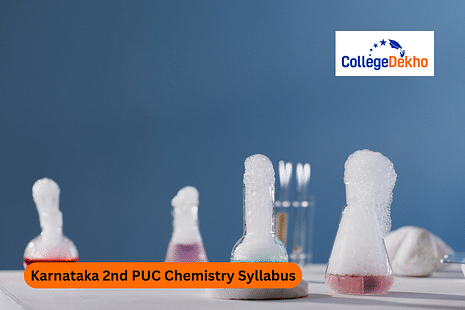

Never Miss an Exam Update
Karnataka 2nd PUC Chemistry Syllabus 2026 outlines all the details of chapters included in the 2nd PUC Chemistry syllabus. It includes chapters such as Solutions, Electrochemistry, Chemical Kinetics, The d and f block Elements, Coordination Compounds, Haloalkanes and Haloarenes, Alcohols, Phenols and Ethers, Aldehydes, Ketones and Carboxylic Acids, Amines, and Biomolecules. The Chemistry exam will be conducted for 70 marks, and 30 marks will be for the practical exam. You can also check the marks allotted to each of the chapters and pay more attention to the chapter with the highest marks.
Students can also download the latest Karnataka 2nd PUC Chemistry Model Paper 2026 and solve the questions regularly. For more information about the Karnataka 2nd PUC Chemistry Syllabus 2026, continue reading.
Latest Updates:
- Nov 28, 2025: The Department of Pre-University Education (DPUE) released the final Karnataka 2nd PUC time table 2026 on the official website - kseab.karnataka.gov.in/. The 2nd PUC board will conduct the Karnataka 2nd PUC exam 2026 from February 28 to March 17, 2026.
Karnataka 2nd PUC Chemistry Chapter-Wise Syllabus 2026
The Karnataka 2nd PUC Chemistry syllabus for 2026 serves as an excellent learning resource for students, offering a detailed overview of chapter-wise topics and their respective marking distribution. By referring to the 2nd puc 2026 syllabus, students can easily identify key topics and chapters with a higher likelihood of appearing in the upcoming board exams.
The table below provides a comprehensive list of chapters along with unit-wise topics inlcuded in the 2nd puc syllabus 2025-26.
Unit Name | Topics |
|---|---|
Unit 1: The Solid State | Nil |
Unit 2: Solutions | 2.1 Types of Solutions 2.2 Expressing Concentration of Solutions 2.3 Solubility 2.4 Vapour Pressure of Liquid Solutions 2.5 Ideal and Non-ideal Solutions 2.6 Colligative Properties and Determination of Molar Mass |
Unit 3: Electrochemistry | 3.1 Electrochemical Cells 3.3 Nernst Equation 3.4 Conductance of Electrolytic Solutions 3.5 Electrolytic Cells and Electrolysis (excluding the elementary idea of laws of electrolysis |
Unit 4: Chemical Kinetics | 4.1 Rate of a Chemical Reaction 4.2 Factors Influencing Rate of a Reaction 4.3 Integrated Rate Equations |
Unit 5: Surface Chemistry |
5.1 Adsorption
|
Unit 6: General Principles and Processes of Isolation of Elements | Nil |
Unit 7: p-block elements | Nil |
Unit 8: d and f Block Elements | 8.1 Position in the Periodic Table 8.2 Electronic Configurations of the d-Block Elements 8.3 General Properties of the Transition Elements (d-Block) 8.5 The Lanthanoids: Electronic configuration, oxidation states, Llanthanoids contraction, reasons and consequences. 8.6 The Actinoids; Actinoid contraction 8.7 Some Applications of d- and f-Block Elements |
Unit 9: Coordination Compounds |
9.1 Werner's Theory of Coordination Compounds
|
Unit 10: Haloalkanes and Haloarenes | 10.1 Classification 10.2 Nomenclature 10.3 Nature of C–X Bond 10.4 Methods of Preparation 10.5 Physical Properties 10.6 Chemical Reactions |
Unit 11: Alcohols, Phenols and Ethers | 11.1 Classification 11.2 Nomenclature 11.3 Structures of Functional Groups 11.4 Alcohols and Phenols 11.6 Ethers |
Unit 12: Aldehydes, Ketones and Carboxylic Acids | 12.1 Aldehydes and Ketones: Nomenclature, nature of carbonyl group, methods of preparation, physical and chemical properties, mechanism of nucleophilic addition, reactivity of alpha hydrogen in aldehydes, uses. 12.2 Carboxylic Acids: Nomenclature, acidic nature, methods of preparation, physical and chemical properties; uses. |
Unit 13: Amines | 13.1 Amines: Nomenclature, classification, structure, methods of preparation, physical and chemical properties, uses, identification of primary, secondary and tertiary amines. 13.2 Diazonium salts: Preparation, chemical reactions and importance in synthetic organic chemistry. |
Unit 14: Biomolecules | 14.1 Carbohydrates - Classification (aldoses and ketoses), monosaccharides (glucose and fructose), D-L configuration oligosaccharides (sucrose, lactose, maltose), polysaccharides (starch, cellulose, glycogen); Importance of carbohydrates. 14.2 Proteins -Elementary idea of - amino acids, peptide bond, polypeptides, proteins, structure of proteins - primary, secondary, tertiary structure and quaternary structures (qualitative idea only), denaturation of proteins; enzymes. Hormones - Elementary idea excluding structure. 14.3 Vitamins - Classification and functions. Nucleic Acids: DNA and RNA. |
Unit 15: Polymers | Nil |
Unit 16: Chemistry in Everyday Life | Nil |
Karnataka 2nd PUC Chemistry Exam Pattern 2026
Marks allotted for each unit have been tabulated below. You can check out the unit-wise Karnataka 2nd PUC Chemistry exam pattern 2026 from the table below:Unit Name | Marks |
|---|---|
Unit 1: The Solid State | -- |
Unit 2: Solutions | 13 |
Unit 3: Electrochemistry | 14 |
Unit 4: Chemical Kinetics | 13 |
Unit 5: Surface Chemistry | -- |
Unit 6: General Principles and Processes of Isolation of Elements | -- |
Unit 7: p-block elements | -- |
Unit 8: d and f Block Elements | 11 |
Unit 9: Coordination Compounds | 12 |
Unit 10: Haloalkanes and Haloarenes | 09 |
Unit 11: Alcohols, Phenols and Ethers | 12 |
Unit 12: Aldehydes, Ketones and Carboxylic Acids | 14 |
Unit 13: Amines | 08 |
Unit 14: Biomolecules | 09 |
Unit 15: Polymers | -- |
Unit 16: Chemistry in Everyday Life | -- |
Students can complete the 2nd puc chemistry syllabus 2025-26 in detail and solve the questions to test their preparation level. For more details, keep visiting the page.
Are you feeling lost and unsure about what career path to take after completing 12th standard?
Say goodbye to confusion and hello to a bright future!

FAQs
The students should prepare the Karnataka 2nd PUC Chemistry Syllabus 2026 in detail. They should cover up all the chapters in the syllabus and ensure they are able to solve the questions.
The units that will be carrying the maximum weightage in the Karnataka 2nd PUC Chemistry exam 2026 are Unit 3: Electrochemistry and Unit 12: Aldehydes, Ketones and Carboxylic Acids. Both these units will carry a total of 14 marks each in the exam.
According to the Karnataka 2nd PUC Chemistry Syllabus for 2026, there are different chapters that will be covered in the curriculum including Solutions, Electrochemistry, Chemical Kinetics, the d and f block Elements, Coordination Compounds, Haloalkanes and Haloarenes, Alcohols, Phenols and Ethers, and so on.
The theory paper for Chemistry will be conducted for 70 marks and the remaining marks will be allotted for the practical exams according to KSEAB. The detailed syllabus for theory and practical will be mentioned in the Karnataka 2nd PUC Chemistry Syllabus 2026 PDF.
The deleted topics from the Karnataka 2nd PUC Chemistry Syllabus 2026 are Unit 1: The Solid State, Unit 5: Surface Chemistry, Unit 6: General Principles and Processes of Isolation of Elements, Unit 7: p-block Elements, Unit 15: Polymers, and Unit 16: Chemistry in Everyday Life.
Was this article helpful?


















